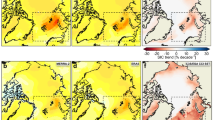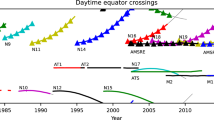Abstract
At thousands of stations worldwide, the mean daily surface air temperature is estimated as a mean of the daily maximum (T max) and minimum (T min) temperatures. We use the NOAA Surface Radiation Budget Network (SURFRAD) of seven US stations with surface air temperature recorded each minute to assess the accuracy of the mean daily temperature estimate as an average of the daily maximum and minimum temperatures and to investigate how the accuracy of the estimate increases with an increasing number of daily temperature observations. We find the average difference between the estimate based on an average of the maximum and minimum temperatures and the average of 1440 1-min daily observations to be − 0.05 ± 1.56 °C, based on analyses of a sample of 238 days of temperature observations. Considering determination of the daily mean temperature based on 3, 4, 6, 12, or 24 daily temperature observations, we find that 2, 4, or 6 daily observations do not reduce significantly the uncertainty of the daily mean temperature. The bias reduction in a statistically significant manner (95% confidence level) occurs only with 12 or 24 daily observations. The daily mean temperature determination based on 24 hourly observations reduces the sample daily temperature uncertainty to − 0.01 ± 0.20 °C. Estimating the parameters of population of all SURFRAD observations, the 95% confidence intervals based on 24 hourly measurements is from − 0.025 to 0.004 °C, compared to a confidence interval from − 0.15 to 0.05 °C based on the mean of T max and T min.






Similar content being viewed by others
References
Augustine JA, DeLuisi JJ, Long CN (2000) SURFRAD—a national surface radiation budget network for atmospheric research. Bull Amer Meteor Soc 81:2341–2357
Augustine JA, Hodges GB, Cornwall CR, Michalsky JJ, Medina CI (2005) An update on SURFRAD—the GCOS surface radiation budget network for the continental United States. J Atmos and Oceanic Tech 22:1460–1472
Bonacci O, Zeljkovic I, Troglic R, Milkovic J (2013) Differences between true mean daily, monthly and annual air temperatures and air temperatures calculated with three equations: a case study from three Croatian stations. Theor Appl Climatol 114:271–279
Brooks C (1921) True mean temperature. Mon Weather Rev 49:226–229
Davis WM (1894) Elementary meteorology. Ginn & Company, Boston
Fall, S., A. Watts, J. Nielsen-Gammon, E. Jones, D. Niyogi, J. Christy. and R. Pielke (2011), Analysis of the impact of station exposure on the U.S. Historical Climatology Network temperatures and temperature trends, J Geophys Res, 116, :https://doi.org/10.1029/2010JD015146
Gonzalez-Hidalgo J, Pena-Angulo D, Brunetti M, Cortesi N (2015) Recent trend in temperature evolution in Spanish mainland (1951-2010): from warming to hiatus. Int J Climatol. https://doi.org/10.1002/joc.4519
Gough W, He D (2015) Diurnal temperature asymmetries and fog at Churchill, Manitoba. Theor Appl Climatol 121:113–119
Hartzell F (1919) Comparison of methods for computing daily mean temperatures: effect of discrepancies upon investigations of climatologists and biologists. Mon Weather Rev 47:799–801
Kämtz LF (1831) Lehrbuch der Meteorologie, Gebaurische Buchhandlung, Leipzig
Karl T, Williams C, Young P, Wendland W (1986) A model to estimate the time of observation bias associated with monthly mean maximum, minimum and mean temperatures in the United States. J Clim Appl Meteorol 25:145–160
Kaspar F, Hannak L, Schreiber K-J (2016) Climate reference stations in Germany: status, parallel measurements and homogeneity of temperature time series. Advances in Science & Research 13:163–171. https://doi.org/10.5194/asr-13-163-2016
Long CN, Ackerman TP, Gaustad KL, Cole JNS (2006) Estimation of fractional sky cover from broadband shortwave radiometer measurements. J Geophys Res 111:D11204. https://doi.org/10.1029/2005JD006475
Menne M, Durre I, Vose R, Gleason B, Houston T (2012) An overview of the global historical climatology network-daily database. J Atmos Ocean Technology 29:897–910
Mitchell JM (1953) On the causes of instrumentally observed secular temperature trends. J Meteorol 10:244–261
Pielke, R., et al (2007), Unresolved issues with the assessment of multidecadal global land surface temperature trends, J Geophys Res, 112, :https://doi.org/10.1029/2006JDD008229
Wang K, Zhou C (2015) Regional contrasts of the warming rate over land significantly depend on the calculation methods of mean air temperature. Sci Rep 5(12324). https://doi.org/10.1038/srep12324
Weber R (1993) Influence of different daily mean formulas on monthly and annual averages of temperature. Theor Appl Climatol 47:205–2013
Williams, C., M. Menne, and P. Thorne (2012), Benchmarking the performance of pairwise homogenization of surface temperatures in the United States, J Geophys Res, 117, https://doi.org/10.1029/2011JD016761
Zeng X, Wang A (2012) What is monthly mean land surface temperature? (2012). Eos 93:156–157
Zhou C., and Wang K. (2016) Spatiotemporal Divergence of the Warming Hiatus over Land Based on Different Definitions of Mean Temperature. Scientific Reports 6:31789, https://doi.org/10.1038/srep31789
Acknowledgements
The reported research (LA-UR-17-21392) was partially supported by the Los Alamos National Laboratory, Earth and Environmental Sciences and by NOAA, Earth System Research Laboratory internal resources. The SURFRAD data used in this report are publically available at the website ftp://aftp.cmdl.noaa.gov/data/radiation/surfrad/RadFlux/
Author information
Authors and Affiliations
Corresponding author
Rights and permissions
About this article
Cite this article
Chylek, P., Augustine, J.A., Klett, J.D. et al. Daily mean temperature estimate at the US SURFRAD stations as an average of the maximum and minimum temperatures. Theor Appl Climatol 134, 337–345 (2018). https://doi.org/10.1007/s00704-017-2277-4
Received:
Accepted:
Published:
Issue Date:
DOI: https://doi.org/10.1007/s00704-017-2277-4




